Lea Wait's Blog, page 85
July 11, 2022
Every Picture Tells a Story
 We moved into our current house in Farmington three years ago just about this time. When I was packing up the last house (in three weeks!), I came across a bulletin board that had been tucked in a closet. I hadn’t seen it for years, and it was like finding a long-lost treasure. I was so excited I even took a photograph. On it was the curled-up sonogram of my grandson (he’s 12 ½ now), other family pictures (that adorable baby is almost 15), several contest award certificates from when I was pre-published, illustrations meant to capture my characters, etc. The bulletin board used to hang over my desk, and I’d stare at it when I got stuck.
We moved into our current house in Farmington three years ago just about this time. When I was packing up the last house (in three weeks!), I came across a bulletin board that had been tucked in a closet. I hadn’t seen it for years, and it was like finding a long-lost treasure. I was so excited I even took a photograph. On it was the curled-up sonogram of my grandson (he’s 12 ½ now), other family pictures (that adorable baby is almost 15), several contest award certificates from when I was pre-published, illustrations meant to capture my characters, etc. The bulletin board used to hang over my desk, and I’d stare at it when I got stuck.
Well, I’m stuck now, and that corkboard is in the garage behind the freezer. It’s pretty inaccessible unless I decide to somehow wedge myself between the wall and the loft stairs without decapitating myself. Everything on it is old news now, though—the books inspired by it have long been published, and I’ve forgotten half the plots, LOL.
But I’m still a visual person, and have a Pinterest account. It’s a very handy way to save images, and I’ve organized them for my three most recent book series. (I also keep recipes too, though I confess I hardly ever cook any of them). I have a collection for the new series I’m working on, and I think I need to scroll through it a couple of times to jog myself out of the half-way mark of the current WIP.
I’ve always loved beginnings—so exciting! Everything’s new and sparkly!—and sometimes I write endings way before I get to them organically. At present I am in the dreaded “mucky middle” of Book #2 of the Lady May Mysteries (move over, Lady Adelaide) and have seemingly been here forever. There is no last page in sight.
To be accurate, I probably have about 25,000 words to go to write The End, so maybe I’m 2/3 of the way through. I have only recently decided who the killer is. As you can tell, I am not a plotter. I wish I was. How envious I am of those writers who have sticky notes and, yes, bulletin boards that outline every chapter. My brain absolutely refuses to work that way (actually, my brain is absolutely refusing to work, period), and it is quite a nuisance. Sometimes I am shocked to realize I’ve managed to write 20+ books in such a haphazard manner, not to mention that I still can’t type with all my fingers.
Here’s what’s caught my eye: (780) Pinterest Check out a young Gary Cooper. Swoon. Do you use Pinterest, mood boards, or have bits of paper all over your desk?
For more about Maggie and her books, please visit www.maggierobinson.net
July 8, 2022
Weekend Update: July 9-10, 2022
 Next week at Maine Crime Writers there will be posts by Maggie Robinson (Monday), Joe Souza (Tuesday), Susan Vaughan (Thursday), and Kaitlyn Dunnett/Kathy Lynn Emerson (Friday).
Next week at Maine Crime Writers there will be posts by Maggie Robinson (Monday), Joe Souza (Tuesday), Susan Vaughan (Thursday), and Kaitlyn Dunnett/Kathy Lynn Emerson (Friday).
In the news department, here’s what’s happening with some of us who blog regularly at Maine Crime Writers:
From Kathy/Kaitlyn: I’ve been doing some updating of my page here at MCW and of my webpages. For the latest, take a look at https://mainecrimewriters.com/kaitlyn-dunnettkathy-lynn-emerson/ or just click on my name in the sidebar. You can find more news and miscellaneous information about my books at http://www.kathylynnemerson.com and http://www.kaitlyndunnett.com
If you’re reading this early enough, come find some of us, and many other wonderful Maine authors, at Books in Boothbay, at the Railway Museum starting at 9:00 a.m. It’s a great way to support authors and gather books for your vacation reading or for gifts.
At last! The results of our “Where Would You Put the Body” contest. Always an impossible task to choose the winners. The minds of the photographers who enter this contest are truly evil indeed.
The winner? Bruce Harris for this:

First runner up? Doris Ray, who put the body in the chimney of Beech Hill Cottage.

And second runner up? Well, many of our entrants understood that with lobster bait in short supply, it’s a perfect place to put a body. The judges think this one wins for artistic merit.

Thanks, everyone to entered. We wish we could award prizes to all of you for your creativity. Judging this year was difficult yet a lot of fun.
Winners, please send your snail mail addresses to writingaboutcrime@gmail.com.
An invitation to readers of this blog: Do you have news relating to Maine, Crime, or Writing? We’d love to hear from you. Just comment below to share.
And a reminder: If your library, school, or organization is looking for a speaker, we are often available to talk about the writing process, research, where we get our ideas, and other mysteries of the business, along with the very popular “Making a Mystery” with audience participation, and “Casting Call: How We Staff Our Mysteries.” We also do programs on Zoom. Contact Kate Flora
POLLEN OR NO POLLEN – WE MUST GO ON
by Jule Selbo

How do you write when the season is against you? When it has decided to perform its yearly duty: blow around some haploid male genetic material from one plant to the stigma of another, hoping to get lucky and cross-pollinate. A pretty random sperm delivery system – but it has worked for – forever? And, okay. Fine. We need it. But, does it also have to draw and quarter very necessary brain cell I have to continue on its business? Does it have to expel aggressive particles with scratchy, knobby nodules that get into tender, moist sinuses, under eyelids, unprotected eye sockets, down my epiglottis and trachea?
 Even as I’m writing this, I’m thinking of the writer Dennis Potter The Singing Detective (and more), and his battle with debilitating psoriatic arthropathy and how he kept writing through the itch and pain; the photo here shows the lead character in the Singing Detective TV series (suffering from psoriatic arthropathy)
Even as I’m writing this, I’m thinking of the writer Dennis Potter The Singing Detective (and more), and his battle with debilitating psoriatic arthropathy and how he kept writing through the itch and pain; the photo here shows the lead character in the Singing Detective TV series (suffering from psoriatic arthropathy)

I now think I’m being a big baby…
But I started my wail, so I’ll continue.
How do you write through monstrous headaches, monstrous clear mucus that erupts like a volcano or becomes a never-ending waterfall of nasal drips?
 Rhinitis. I get why it’s called that (‘Rhino’ being Greek for ‘concerning the nose’ – it’s how rhinoceros got their name (for the large horn on their nose). Sometimes, in pollen season, I can feel like my nose is the size of a rhino’s.
Rhinitis. I get why it’s called that (‘Rhino’ being Greek for ‘concerning the nose’ – it’s how rhinoceros got their name (for the large horn on their nose). Sometimes, in pollen season, I can feel like my nose is the size of a rhino’s.
I wake up stuffy and slow-minded, I shuffle instead of prance in the morning light. Feels like a 5-martini hangover (well, maybe it does, I’ve never had five in one sitting).
Sometimes I dream of a sympathetic guillotine that could neatly, quickly, severe my head. But I don’t relish that permanence. So I imagine a Dr. Frankenstein puppeteer who can, hourly, unhook my head, put it in a deep freeze to cool and clear, then re-attach it so I can get on with my daily grind.
I cut off the fantasies to deal with reality. I determine to not let inanimate particles sideline me. I have a deadline. And not making a deadline (for me) can bring on a critical condition much worse than an allergy attack.
But how to push forward?

Maureen Milliken’s observations on writing, in her June 29, 2022 post, mentioned the help of story prompts. She noted that if a roomful of (let’s say) twenty writers are given the same prompt, there would be twenty very different responses, story ideas, and/or characters built. She noted how prompts can be like the jolt of a cattle prod and can get our fingers flying.
I’ll add another possibility. If there’s no one providing that prompt (or you’re not feeling self-motivated to make up one for yourself, here’s my trick – and the history of it.
It was a pivotal day for me, thirty some years ago. I was a newbie playwright, right out of graduate school, and having my first play produced off-off Broadway in NYC. The play had caught the eye of a producer who was (then) married to Pulitzer Prize winning playwright Marsha Norman (‘Night Mother, Getting Out, The Secret Garden etc.).

I was invited to a cocktail party with other struggling playwrights at their oh-so-upscale condo near Lincoln Center, one of those renovated, highly-coveted artists’ lofts with huge back windows that let in northern light and overlook an expansive (rare for NYC) garden. The building sported a maroon-ish black, jagged brick exterior, a marble lobby, and a burly but elegantly mustached doorman in a black suit with gold epaulets on his shoulders. He watched me sign in – that was a prerequisite to being allowed to the step towards the gleaming, gold elevator. His appraisal was felt, I could almost read his thoughts: “hey kid, you’re not wearing Gucci or Prada – so what right do you have to enter this domain?” (Reminder: this was all from an insecure 24-year-old’s point of view.)
Inside the condo’s cherry-wood paneled living room, Marsha sat like an unhappy queen, clearly not in the mood to be inconvenienced by her schmoozy, hardworking partner’s desire to throw a little party to support up-and-coming writers whose plays he might produce one day. Maybe she’d had a bad writing day, maybe she and her hubby had argued, maybe the guest list was not up to her standard, maybe she had just met with her divorce attorney that day (the divorce came pretty soon after), but for whatever reason, she was very unsocial, bordering on very unfriendly.

Another neophyte, who was only trying to make conversation with the woman whose career we all admired, asked how she dealt with writer’s block – or writer’s doldrums – not being able to get started on any particular day. Marsha sniffed and sneered, nearly gave us an eye-roll, but she deigned to answer. “Read. Read. Read,” she said. “And then, at some point, find a scrap of dialogue or a sentence you particularly like in the book or playscript you’re reading – get off your ass, and type it onto your blank page. Then rewrite it in your voice. And somehow make it work in your story. Use it as a jumpstart… and then just get over yourself and get on with it.”
The unhappy, unfriendly lady unwittingly had given me a great gift. From that day on, if I was stuck on my latest play (that was my focus then but I continued to use it as I moved into different modes) and was close to dumping it into the trash, I would grab a script from off my desk, and read.
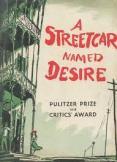 It worked like this: let’s say I happened to pick up Tennessee Williams’ famous (infamous for its time) Streetcar Named Desire and his lionized line “Whoever you are – I have always depended on the kindness of strangers…” popped out at me. I might get up off my reading chair, head to my computer and – thinking about my own play and its story, begin to type: “Never trust a stranger, who knows if he might be a friend or foe?” And once I put those words into one of my character’s mouth – possible responses and maybe even a plot twist or character quirk would start to intrigue me.
It worked like this: let’s say I happened to pick up Tennessee Williams’ famous (infamous for its time) Streetcar Named Desire and his lionized line “Whoever you are – I have always depended on the kindness of strangers…” popped out at me. I might get up off my reading chair, head to my computer and – thinking about my own play and its story, begin to type: “Never trust a stranger, who knows if he might be a friend or foe?” And once I put those words into one of my character’s mouth – possible responses and maybe even a plot twist or character quirk would start to intrigue me.
Maybe there’s something to be said for the reading of great writing that, through a weird osmosis, gets another writer energized to get back to the keyboard. But soon, for me, the base writing didn’t necessary have to rise to laudatory levels – there was inspiration everywhere – the other day, sitting behind home plate at Hadlock Stadium, watching the Sea Dogs play the Flying Squirrels, I was reading about fuzzy “Nutzy” and his female pal “Nutahsa”, the visiting team’s mascots. Their history fascinated me and inspired a character nugget for my latest villain (he’s not going to put away acorns for the winter but…)

Inspirations:



Sure, truth be told, the new sentence or idea might not (often didn’t) end up in the final product, but it got me out of a procrastination/self-loathing/ laziness/blahs and back into a few hours of joyous writing.
Any other tips out there?
July 6, 2022
Salmon and Peas
 I’m writing this on the Fourth of July, a day to think about both the founding and current state of our nation.
I’m writing this on the Fourth of July, a day to think about both the founding and current state of our nation.
Dinner will be salmon and peas, a culinary tradition I’ve adopted in adulthood. When I was a child, the holiday repast involved hotdogs and hamburgers, potato salad and ice cream. But these days we eat more fish than meat, and we have made it our ritual to eat salmon, new potatoes and peas on Independence Day, as the early settlers of New England did.
Eating local was the only option in the early days of this country. After a winter of root vegetables and dried, salt-cured meat, a Fourth of July meal of fresh fish with just-picked peas and newly dug potatoes must have been a celebration indeed. At that time, the summer salmon migration upriver from the Atlantic Ocean provided an abundance of protein-rich fish, so it’s no surprise salmon on the Fourth became a traditional meal throughout the region.
The habitat for Atlantic salmon was undermined beginning in the middle of the eighteenth century when industrialization led to rivers across New England being dammed to provide power to the mills along their banks. It either didn’t occur to the dam builders that the river-spanning monoliths would harm the native fish population or they didn’t care, but blocking the rivers prevented sea-run salmon from reaching their spawning grounds.

In addition, until implementation of the Clean Water Act, industrial pollution degraded the water quality to the point that the populations of wild salmon and many other fish species pretty much collapsed. In 2022, Maine is the only state that still has a population of Wild Atlantic salmon, but its endangered status puts it off limits to both the commercial and recreational fishery.
However, as the cultural anthropologist Margaret Mead is reported to have said, “never doubt that a small group of thoughtful, committed citizens can change the world; indeed, it’s the only thing that ever has.” In recent decades, small groups of committed citizens have dedicated themselves to dam removal and the restoration of water quality in Maine’s rivers, a fact that gives me hope in these days when it is in short supply.
The Presumpscot runs through my community of Westbrook,  and it’s a different river today than it was in the mid-1990s, when a concerted restoration effort began. The Friends of the Presumpscot River, the Coastal Conservation Association, the National Fish and Wildlife Foundation and the Conservation Law Foundation, as well as government entities such as the Army Corps of Engineers, the Maine Department of Marine Resources and the U.S. Fish & Wildlife Service have collaborated since that time on reviving the Presumpscot and its wild salmon fishery. The story of their work is captured in this article: https://www.fws.gov/story/rallying-round-presumpscot
and it’s a different river today than it was in the mid-1990s, when a concerted restoration effort began. The Friends of the Presumpscot River, the Coastal Conservation Association, the National Fish and Wildlife Foundation and the Conservation Law Foundation, as well as government entities such as the Army Corps of Engineers, the Maine Department of Marine Resources and the U.S. Fish & Wildlife Service have collaborated since that time on reviving the Presumpscot and its wild salmon fishery. The story of their work is captured in this article: https://www.fws.gov/story/rallying-round-presumpscot
Appreciation for the river—its history, its natural resource values and its future potential—informs the common commitment of those who are involved in this important work. To me, the mix of volunteer and governmental organizations on this list is particularly powerful.  Since the 1970s, enormous strides have been made to clean up our water and air, and the most far-reaching and enduring results have been when governmental agencies have coordinated and worked cooperatively with groups of citizen volunteers dedicated to protecting and preserving treasured places and precious water bodies.
Since the 1970s, enormous strides have been made to clean up our water and air, and the most far-reaching and enduring results have been when governmental agencies have coordinated and worked cooperatively with groups of citizen volunteers dedicated to protecting and preserving treasured places and precious water bodies.
Last week the US Supreme Court showed itself to be out of step with this thinking. In West Virginia v. Environmental Protection Agency, a 6- 3 court ruled the EPA does not have authority to regulate power plant emissions. The case was about clean air, but the ruling will almost certainly have implications on clean water efforts and many other environmental initiatives. Unless Congress acts, the EPA’s role and resources will be curtailed.
What can you do if you want to be sure not only you but future generations will be able to access Maine rivers for fishing, boating, hiking, birdwatching or any other environmentally sustaining purpose?
Join and support volunteer organizations in your area dedicated to the health and vitality of Maine’s rivers. For those who live near the Presumpscot River, information about educational programs and volunteer opportunities can be found here: https://www.presumpscotriver.org/Contact your Congressional representatives about the value of Maine rivers and the need to protect them with laws that specifically grant to regulatory agencies the authority to implement environmentally positive policies such as emissions controls and dam removal. If you need some talking points, check out this video: https://www.presumpscotriver.org/blog/2018/5/6/tales-of-the-presumpscot-healthy-rivers-healthy-oceansAsk my blogmates Richard Cass and Sandra Neily for their ideas about effective action. Dick is a lifelong fly fisherman and Sandy knows about Maine Rivers that I ever will. I’m sure they have plenty of suggestions.Register to vote. If you’re registered already, encourage those in your life who are not registered to do so.Vote like the quality of your life depends on it. Because it does.Brenda Buchanan brings years of experience as a journalist and a lawyer to her crime fiction. She has published three books featuring Joe Gale, a newspaper reporter who covers the crime and courts beat. She is now hard at work on new projects. FMI, go to http://brendabuchananwrites.com
July 5, 2022
And It Came To Pass

A darkness was spreading over the world and had covered a frightening portion before the Cosmic Caretaker noticed. They had been so engrossed in the latest book borrowed from the Library at the Center of the Universe, their dereliction of duty was almost forgivable. They placed a bookmark at the end of a particularly juicy chapter and set it down.
“Damn humans,” They muttered, observing multiple disasters unfolding around the globe. “They give more trouble than any other six worlds under my care combined. Well, grousing isn’t gonna fix much, so where should I begin.”
They got up to speed by watching several hours of media broadcasts, realizing all too soon that most of what humans considered news was anything but. Fixing that was as good a place to start as any. They snapped their fingers and social media was filled with cute cat photos and prancing unicorns. Every time anyone tried to post something hateful or untrue, they lost a finger and their device melted.
They turned to the networks. There was so much bias passing for news, they wanted to initiate a blackout. Instead inspiration hit and every time someone tried to pass off a lie, or a distorted fact as news, they turned into a chicken. In short order, newsrooms across the globe were cleaning up chicken poop, broken eggs and loose feathers.
They sat back to watch the carnage and realized there were more serious issues at hand than disinformation. Evil was rampant, and the number of souls perpetrating it was far beyond what human laws and morality could deal with. “Well, desperate measures and all that,” they muttered. What was that old sports adage humans used-Addition by subtraction, or something like it. They didn’t want to create a new problem while trying to fix another. Ten million is a good number to start with, they thought and snapped their fingers again. When the full moon rose that evening, people all over the globe were stunned at the change on its surface. A pile of evil people, ten million in all, was visible to the naked eye.
Unfortunately a scramble ensued to fill power vacuums everywhere as a result. Fortunately the Cosmic Caretaker had a Plan B. Anyone perpetrating an act of violence following the mass export of evildoers to the moon, was turned to stone. Public works departments had to hire additional staff and rent front end loaders in order to free streets and public buildings. It seemed like there was an endless number of fools in the human race, but after six months, the number of new statues slowed to a trickle.
Cleaning up evil was just the beginning. They turned their attention to damage done to the planet by unchecked development, greed, and stupidity. This was where the Cosmic Caretaker’s creativity really came to the fore. The quickest way to right the ship known as Mother Earth was to capture carbon, and they did so with a flourish. Flying devices sucked it from the atmosphere and the oceans before compressing it into diamond hard sheets that were superimposed over decaying roadways. Excess went into building giant greenhouses. Construction company and paving executives cried foul, but taxpayers and government officials secretly, and not so secretly celebrated. When global temperatures started dropping back to normal, and drought-stricken areas began experiencing rainfall again, more of humanity celebrated.
After brewing a fresh pot of coffee, the Cosmic Caretaker read for a bit before resuming their cleanup of the dumpster fire known as Planet Earth. They had a special fondness for the State of Maine, having camped in the northern part when they were younger. This time, a giant delta-winged craft made measured passes across the state, sucking up ticks, Browntail Moth caterpillars, and green crabs until none were left. Once they were captured, the haul was compressed and shot off, to descend weeks later through the super hot and acidic atmosphere of Venus. Sure, some of each species would migrate back into the state, but the moderating temperature would make the numbers negligible.
They thought for a bit over a second cup of coffee. The obsession with other peoples’ private lives and bodies disgusted them. Another finger snap was in order, they decided, but it needed to result in something so startling it couldn’t be ignored. “Of course,” they said with a smile. “A play on a book title would be a perfect tough. In a matter of days, all the zealots who wanted to inflict their values on women of childbearing age, found themselves with a womb, complete with a view port, filled with nearly mature porcupine fetuses. “Serves those pricks right,” they muttered.
The Cosmic Caretaker knew they couldn’t fix everything on the first pass, but one particularly annoying aspect of their earthly check-ins was how sloppy and lazy many inhabitants were. Trash was scattered all over, with dog poop being the most offensive. This fix required a double finger snap which was tiring, but the results were criminally satisfying. When offenders turned in for the night, they found their discards placed under the sheets.
There was one final action they needed to take before sitting back and letting Earth do its thing unsupervised. Humans treated weapons like kindergarten kids treated toys-recklessly. They snapped their fingers and all bombs, both nuclear and conventional softened, becoming huge blobs of silly putty. Attempts to make more elicited a similar result. Firearms were next. Any attempt to use one to hurt another human resulted in the barrel making a U-shape and shooting the perpetrator. Knives being used against another, except when the holder was defending themselves, became venomous snakes that bit the attacker. The homicide rate dropped to all time lows, and emergency rooms heaved a collective sigh of relief.
“It’s not perfect, but when has anything been so,” They muttered, turning their attention to making lunch. They had another pressing task this afternoon. Three new books had come in at the library and were calling their name in a most seductive manner.

(This is what my brain does after reading the daily newspaper. Hope you had a great Fourth of July)
July 4, 2022
As American as a Bailey Island Ice Cream Social
This post ran the first summer of our Maine Crime Writers blog. We’re are now in our eleventh year. The cast of writers changes but the insights into writing, and Maine, and how writers see the world continue. I’m not sure today’s ice cream social down the road at Library Hall still starts at two, but it will happen, and it will always be a fun part of a Bailey Island summer.
Kate Flora here. As a native Mainer (Union High School class of I’m not telling you) who’s gone away and come back, I’m now enjoying my twenty-second Bailey Island summer, where I struggle to keep my eyes on the computer screen and my mind of my work when I’m constantly drawn into watching fog and sunsets, clouds and lobster boats, osprey, eider ducks, and seals. This is a new part of the state for me. I misspent my youth around Rockland and Camden and I set my Joe Burgess police procedurals in Portland. It’s also, like so much of Maine, as photogenic as a beauty queen.
Bailey Island, part of the town of Harpswell and located at the end of a chain of islands starting from

Cook’s Corner in Brunswick and crossing Great Island and Orrs Island, is reached by an historic (and scarily narrow when you meet a huge truck full of lobsters) bridge, the Cribstone Bridge, made of granite blocks that resemble the pieces in a child’s Jenga toy. It’s a drive worth taking if you’re someone who loves to round corners and be greeted by wonderful views. Maine has over 3000 miles of coastline, and 218 of them are in Harpswell. A hundred years ago, boats used to bring people up from Boston to stay at the hotel, or to board with locals for the summer. Now our summer people arrive by car and SUV, carrying kayaks or towing boats, still looking for that salty tang in the air, the gorgeous vistas of bays dotted with green islands, and the cool ocean breezes.
Like many another who has “discovered” a special part of Maine, I’m always torn between wanting to share my part of the state, and wanting to protect it from an influx of too many people. But the beauty and charm of Bailey Island cries out to be shared, so today I’m going to take you across the bridge, past Giant Stairs Cafe, past our tiny post office that residents raised the money to keep open, and BIGGS (Bailey Island General Store) and on to Library Hall, where the annual Fourth of July Ice Cream social is held.
 Library Hall, a former library and community meeting hall that now hosts wedding receptions and art shows as well as community meetings, sits on a hill overlooking a broad open field and Mackerel Cove, a working lobstering harbor, where the boats start going out at 4:30 in the morning, and the thrum of diesel engines echoes around the cove.
Library Hall, a former library and community meeting hall that now hosts wedding receptions and art shows as well as community meetings, sits on a hill overlooking a broad open field and Mackerel Cove, a working lobstering harbor, where the boats start going out at 4:30 in the morning, and the thrum of diesel engines echoes around the cove.
On July 4th, Library Hall is set with festive

Giant Stairs on Bailey Island
holiday tables. The gathering is community at its best. The narrow road is choked with cars and the lawn overflows with residents and their guests, as generations of year-rounders and summer folk, from senior citizens to newborns, come together to share a long-standing Bailey Island tradition. Costumes and crazy hats abound. Red and white and blue is de rigueur. One group is running a raffle; another group is giving out information about raising money to help buy one of the island’s treasures, a rock-bordered ribbon of sand called Robinhood Beach.
 Inside, visitors who can tear themselves away from the view and the fresh sea breezes on this gloriously clear July afternoon find one of the great bargains of the summer: two scoops of ice cream on top of a brownie, with chocolate sauce and strawberry sauce and whipped cream and a cherry, topped with a teeny American flag on a toothpick, plus a cup of lemonade, all for the giant price of $3.00. It’s especially delicious eating sitting on the broad steps, in the shade of a tree, looking out at the white sails of boats moving among the islands.
Inside, visitors who can tear themselves away from the view and the fresh sea breezes on this gloriously clear July afternoon find one of the great bargains of the summer: two scoops of ice cream on top of a brownie, with chocolate sauce and strawberry sauce and whipped cream and a cherry, topped with a teeny American flag on a toothpick, plus a cup of lemonade, all for the giant price of $3.00. It’s especially delicious eating sitting on the broad steps, in the shade of a tree, looking out at the white sails of boats moving among the islands.
Many try to get there early to be in time for one of the highlights of the afternoon–the Kazoorchestra. Clad in red, white and blue topped with crazy hats,  with the smallest members arriving in a giant lobster trap pulled by a truck, this group comes marching down the main street, which is also route 24, which is also, in fact, about the only street on Bailey Island. When they arrive, they hand out kazoos to anyone who’s feeling patriotic, adventurous or musical (this last might be debatable) and the band plays on. God Bless America may not sound quite melodic, but the combination of neighbors and friends, laughing, capering children and ninety-year-olds smiling from their chairs carries it straight to the heart.
with the smallest members arriving in a giant lobster trap pulled by a truck, this group comes marching down the main street, which is also route 24, which is also, in fact, about the only street on Bailey Island. When they arrive, they hand out kazoos to anyone who’s feeling patriotic, adventurous or musical (this last might be debatable) and the band plays on. God Bless America may not sound quite melodic, but the combination of neighbors and friends, laughing, capering children and ninety-year-olds smiling from their chairs carries it straight to the heart.

July 1, 2022
Weekend Update: July 2-3, 2022
 Next week at Maine Crime Writers there will be posts by Kate Flora (Monday), John Clark (Tuesday), Brenda Buchanan (Thursday), and Jule Selbo (Friday).
Next week at Maine Crime Writers there will be posts by Kate Flora (Monday), John Clark (Tuesday), Brenda Buchanan (Thursday), and Jule Selbo (Friday).
In the news department, here’s what’s happening with some of us who blog regularly at Maine Crime Writers:
An invitation to readers of this blog: Do you have news relating to Maine, Crime, or Writing? We’d love to hear from you. Just comment below to share.
And a reminder: If your library, school, or organization is looking for a speaker, we are often available to talk about the writing process, research, where we get our ideas, and other mysteries of the business, along with the very popular “Making a Mystery” with audience participation, and “Casting Call: How We Staff Our Mysteries.” We also do programs on Zoom. Contact Kate Flora
June 30, 2022
What a Writer Reads
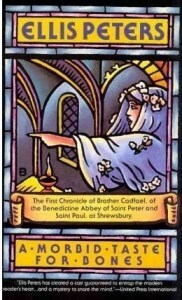 Kaitlyn Dunnett/Kathy Lynn Emerson here, taking a look back at my checkered career and once again finding a convenient topic to blog about. I’ve mentioned before that I’ve been rereading many old favorites since the pandemic began. Let’s face it. There’s nothing like a good comfort read (or escapist fiction, if you will) to take one’s mind off real-world problems.
Kaitlyn Dunnett/Kathy Lynn Emerson here, taking a look back at my checkered career and once again finding a convenient topic to blog about. I’ve mentioned before that I’ve been rereading many old favorites since the pandemic began. Let’s face it. There’s nothing like a good comfort read (or escapist fiction, if you will) to take one’s mind off real-world problems.
Some of the books I chose to lose myself in have penciled-in dates on the flyleaf to indicate when I read that particular novel in the past. A fair number have more than one such notation, and some go as far back as the 1980s. That started me thinking.
I got serious about writing a novel in 1976. I sold my first fiction, a short story for children, in 1980. In 1982, I started using daily planners, a practice I still follow. Along with appointments, I write down what I’m working on, where I’ve submitted a manuscript, and the title of any book I’ve just finished reading. With the exception of reference books, the ones I don’t need to read from cover to cover to find whatever detail I’m looking for, my daybooks contain a record of every book I’ve read for the last forty years.
What a writer reads can’t help but influence what she writes. I’ve written in several genres over those four decades, and when I was just getting started in each new one, I read a lot of books in that genre to get a feel for what worked and what didn’t. From 1982-86, I was heavily into novels written for ages eight to twelves, since the first fiction I sold was for that age group. What I didn’t remember was how many mysteries I was reading in those years, or that they would lay the foundation for what I’d write in the future.
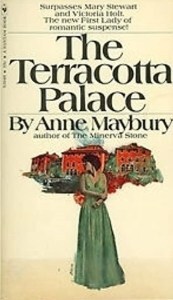 The titles in those early daybooks include many classic mystery novels—a lot of books by Agatha Christie and Marjorie Allingham with a sprinkling of Ngaio Marsh and Dorothy L. Sayers—but I was also reading romantic suspense, particularly Phyllis A. Whitney, Mary Stewart, and an author most people today probably haven’t heard of—Anne Maybury. At the same time, I was borrowing heavily from my local library, where the mystery collection ran heavily to just a few writers. Some continued to write while others apparently faded away. I discovered Elizabeth Peters and Charlotte MacLeod, both of whom I’ve reread many times, but I also read lots of titles by Anne Morice and Anthea Fraser. With few exceptions, most of what I read fell into the “traditional” category.
The titles in those early daybooks include many classic mystery novels—a lot of books by Agatha Christie and Marjorie Allingham with a sprinkling of Ngaio Marsh and Dorothy L. Sayers—but I was also reading romantic suspense, particularly Phyllis A. Whitney, Mary Stewart, and an author most people today probably haven’t heard of—Anne Maybury. At the same time, I was borrowing heavily from my local library, where the mystery collection ran heavily to just a few writers. Some continued to write while others apparently faded away. I discovered Elizabeth Peters and Charlotte MacLeod, both of whom I’ve reread many times, but I also read lots of titles by Anne Morice and Anthea Fraser. With few exceptions, most of what I read fell into the “traditional” category.
Ellis Peters is another name that frequently crops up in my early daybooks. When I began writing my Face Down series, I consciously copied her regular use of a subplot involving a young couple in love. In many of her books, Brother Cadfael helps the courtship along while also solving the mystery at the center of the novel.
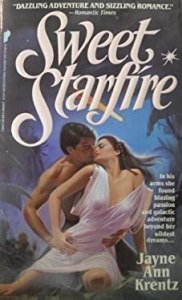
I’ve read this futuristic romance at least seven times since 1989
And speaking of romance, by the late 1980s, I’d discovered category romance (with torrid love scenes!), a relatively new genre at the time. Historical romance was a separate genre, and took longer to catch on. I apparently read 425 books in 1988, most of them romance novels. I still reread authors I discovered way back then—Nora Roberts and Jayne Ann Krentz in contemporary romance and romantic suspense, and Mary Jo Putney and Jo Beverley in historical romance. When I started writing romance myself. I ended up selling ten contemporary romances (nine of them “category” romances for lines like Silhouette Intimate Moments and Bantam Loveswept) and five historical romances.
In skimming through some of my oldest daybooks, it’s clear that most of what I was reading was directly related to what I was about to write. Once I was actively writing in a genre, though, I usually tried to avoid reading other writers in the same genre. I didn’t want my subconscious to start imitating anyone else’s style. Instead, I read in genres I was not writing. Science fiction was an early favorite. In 1985, I read Harry Harrison’s entire Stainless Steel Rat series. Later I tended to read Regency romance. It was highly unlikely I’d ever try to write in either of those genres and they made a nice change from what I was working on. I kept up that practice, more or less, throughout my career. If I was writing cozies, I read historical novels, and vice versa, and sprinkled in between was a lot of romantic suspense.
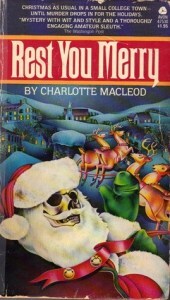 Now that I’m semi-retired, I can read anything I want, and I have one big advantage when I decide to reread a book because I enjoyed it in the past: I rarely remember much of the plot, especially if a few years have passed since I last read it, so I don’t have to worry about recalling so much detail that it spoils the story.
Now that I’m semi-retired, I can read anything I want, and I have one big advantage when I decide to reread a book because I enjoyed it in the past: I rarely remember much of the plot, especially if a few years have passed since I last read it, so I don’t have to worry about recalling so much detail that it spoils the story.
Any other re-readers out there? Have you kept track of how many times you’ve reread a favorite book? Is there one you reread at certain seasons? I often reread Charlotte MacLeod’s Rest You Merry as a Christmas treat.
Kathy Lynn Emerson/Kaitlyn Dunnett has had sixty-four books traditionally published and has self published others, including several children’s books. She won the Agatha Award and was an Anthony and Macavity finalist for best mystery nonfiction of 2008 for How to Write Killer Historical Mysteries and was an Agatha Award finalist in 2015 in the best mystery short story category. She was the Malice Domestic Guest of Honor in 2014. Her most recent publications are The Valentine Veilleux Mysteries (a collection of three short stories and a novella, written as Kaitlyn) and I Kill People for a Living: A Collection of Essays by a Writer of Cozy Mysteries (written as Kathy). She maintains websites at www.KaitlynDunnett.com and www.KathyLynnEmerson.com.
What Makes a Good Book? By Matt Cost
What makes a good book is a conundrum. For many years a good book has been determined by a select few reviewers who dictate whether a book has literary merit. But the truth of the matter is that most (almost all) readers do not have a PhD in English nor an MFA in writing. Doesn’t it stand to reason that the majority of readers will have different tastes in books than the reviewers, certainly those at the most established and hallow of institutions?
If not reviewers, then, perhaps it is popularity as determined by lists such as the New York Times Bestseller List or the Amazon Best Sellers. Interestingly enough, these two lists have very few crossover titles. They are both based on algorithms only known to the powers that be, and again, are suspect in how accurate that they are.
The New York Times collects their data from a smattering of stores across the country ranging from big box stores, large chains, and small independent shops. They do not share from which particular sellers that data is compiled. They do take into account Amazon sales, but not to the tune of the 65% of market share that Amazon controls. In other words, it is not a accurate list.
Amazon is even more disingenuous. They don’t share their algorithm for determining sales but say it involves past rankings, current trends, product price changes and promotions, and other things as well. Other things? It seems to me this would be simple. They sold 113 copies of MOUSE TRAP and that was more than the competitor, MIND TRAP, at 111 copies. Nope. Activate the algorithm. That is not how it works. Nobody knows how it works.
So, if literary reviewers are merely opinion based human beings based on life experiences that don’t match hardly any of the population, and popularity indexes are suspect at best, what are we left with in determining a good book?
Here is my guide to choosing the book that is right for you.
1) Find reviewers, big or small, who speak to you. Chances are, you’re not going to like the same books espoused in the New York Times Book Review. That doesn’t mean you don’t like reading. That just means they don’t speak for you. Find YOUR reviewers.
2) Share books that you liked with friends without judgement. Maybe you like romance. Good for you. So does most of the world. Maybe your thing is horror, or fantasy, or mystery. Heck, maybe you’re an adult who loves young adult titles about historical characters. You have to be honest with yourself, speak up, and share what you like. And listen to others that do as well.
3) Know what you like, or more importantly, what you don’t like, and pick accordingly. I recently had a reader ‘shelve’ one of my books as potty mouth. Yes, it has bad language. If you are offended by swearing, don’t read books that contain it. The same goes for violence and sex.
4) Pacing: Characters, adjectives, description, and setting (CADS). How fast or slow do you like the story to go? If you prefer breakneck speed, you might not like page-long descriptions of characters using many adjectives to fill out the setting of the book. Or vice versa. Many people love detailed and lyrical prose on every facet of the book. Chances are you fall somewhere in the middle.
In summary, be honest with yourself in what you like to read. Then, find reviewers, friends, and authors that represent that genre you call your own and live there. Read on. Write on.
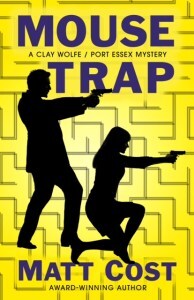
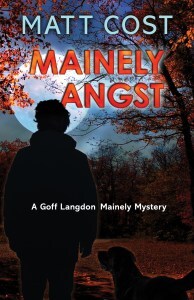
Matt Cost is the highly acclaimed, award-winning author of the Mainely Mystery series, the Clay Wolfe/Port Essex series, and several works of historical fiction.
Cost was a history major at Trinity College. He owned a mystery bookstore, a video store, and a gym, before serving a ten-year sentence as a junior high school teacher. In 2014 he was released and began writing. And that’s what he does. He writes histories and mysteries.
Cost now lives in Brunswick, Maine, with his wife, Harper. There are four grown children: Brittany, Pearson, Miranda, and Ryan. A chocolate Lab and a basset hound round out the mix. He now spends his days at the computer, writing.
June 28, 2022
Some questions and answers for writers about how to get started
I was chatting with a neighbor the other day, and it turns out she’s been working on a book for several years, but is stuck and wondering where she can get support, information, resources, etc. In short, shes wanted to know how she could learn more about writing.
Some of her questions reminded me of the questions I had way back when I was trying to write my first book. That made me think that there may be other writers who have similar questions.
Keep this in mind with every answer, so I don’t have to keep saying it, that everyone is different. Every writing process is different. Figure out what works for you, then do it.
Q. Do I need to take special writing classes? I tried one once, and didn’t really like it. Oh, and I don’t have any money, anyway.
A. No, you don’t need to take special writing classes. You can if you want to, but it’s not required. But you do need to find some way to learn more about that craft than you know now.
The number one thing to do is read as much as you can, both good books and bad books. Think about what you like and don’t like and figure out what they’re doing that works. Read criticism as well — it’ll make you think about your writing. I don’t mean book reviews, since most aren’t that helpful. Look online for “literary criticism.”
ind writing resources that help you learn how to do what you want to do. Understand grammar, puncutaiton, word use and the more complicated things like point of view, first person vs. third person and more.
One book that’s necessary to have — and yes, buy the book, is the Chicago Manual of Style. This is the style book that the publishing industry uses and will help with the technical stuff. Also dig out your old Strunk & White “Elements of Style,” and if you don’t have one, go buy one. Yes, buy a hard copy of the book (more on this in a minute). One book I always recommend is “Don’t Murder Your Mystery,” by Chris Roerden. It’s an excellent resource for learning about bad writing habits and how to overcome them. You don’t have to be writing a mystery to benefit from Roerden’s advice.
The reason I say buy the hard copy of the book is that you want to have them handy as references. You should actually read “Elements of Style” and “Don’t Murder Your Mystery” all the way through. You’ll want to put sticky notes in them and bookmarks, so you can go back and remind yourself of things. Just because the internet exists doesn’t mean it’s the best way to use a resource. That doesn’t mean you can’t look up stuff on the internet, too. Just, for these resources, buy them and use them.
Another thing I recommend is to attend the New England Crime Bake, even if you’re not writing a mystery. You will meet fantastic people who are doing exactly what you’re doing, attend panels and workshops that’ll answer a lot of your questions and find out how to access resources and more.
One last thing. Learn to diagram sentences. I’m not having fun with you, I’m serious. It’ll improve your writing and editors will love you. Even if you were force-fed it by really mean nuns in grade school, give yourself a refresher.
2. Should I join a writing group?
It’s up to you. The benefit is that you have kindred souls you can discuss writing with, and if they are the right people, they’ll also help you make your writing better. Sometimes it’s hard to find a good fit, so keep that in mind. But don’t shy away just because you’re afraid to have people read and critique your writing. If you want your book to get published, you have to get used to that. You’ll eventually learn what criticism is worthwhile and what type of it isn’t. If they’re not getting what you’re doing, and you’re confident that you know what you’re doing and have done the work to back it up, it’s not the right fit. If you find that what they discuss with you makes sense and it’s making your writing better, it’s the right fit.
3. But if they read my stuff, they may steal it, right?
No. They won’t. If you gave 10 people in a room a writing prompt, they would all come up with wildly different stories. Only you can write what you’re going to write, since it’s coming from inside your head. Sure, they can try — though in my 15 years of blabbing on and on and on to other writers about my plots, characters, story lines, etc., no one has ever stolen squat from me that I know if. This isn’t to say there may not be some people without great imaginations who need to steal from their writing group pals, but they’re not going to do with it what you would, so don’t sweat it. There are much bigger things to worry about, believe me.
And think about this — you just spent 20 minutes describing every minute detail of your book to me. Every. Single. Detail. And you didn’t even know me when we began talking. So, obviously you need to talk about it with someone Now, just hang tight right here, I gotta get home to my laptop and get all that down. Kidding! I have my own book going on in my head. Yours is yours. I think most writers feel the same way.
4. I know I’ve seen books with similar plots, you even told me your first book, COLD HARD NEWS, started with a body in a snowbank, and I know I’ve read other books with bodies in snowbanks, um, so. Just saying.
Yes, it can be worrisome when you’re writing and you see some reference to some other book, and it has something yours has in it too. You’re afraid either 1) everyone will think you copied or 2) you and this other person have both written the exact same book, so you have to scrap yours and start with something new since theirs is being reviewed in People magazine and yours is still 59,000 words of blah blah blah.
Neither of those things will happen. (See answer to question 3.) When that starts to worry me, I just channel Sister Catherine, my seventh and eighth grade English teacher, who told us, triumphantly and constantly, “No writer is original! Even Shakespeare wasn’t original!” Hit yourself on the shoulder really hard with a ruler, too, so you don’t forget it. Not that that ever happened to me.
5. How do I write good dialogue? It’s really hard!
Yes, it is. Writing is hard. The best way to write good dialogue is to know your characters well. Think of how they would speak and what they need to say in the scene. Don’t just borrow lines from buddy movies, because the dialogue in those movies sucks. I was a judge in the Writer’s Digest self-published contest for several years and if I see one more scene were someone gets hurt, but says cheerfully, “I’m okay!” or “I’m too old for this shit,” I’m going to throw my Netflix subscription out the window.
I can tell by the look on your face that answer wasn’t the quick fix you wanted to hear, but the better you know your characters, know what’s going on in a scene and know how much and how little to say, the better your dialogue will be.
6. I know you keep saying writing’s hard, there are no quick fixes, blah blah blah, but give me something. Isn’t there something?
Yes. And you’ve already heard it. Stephen King in another excellent writing book, “On Writing,” says to sit down and write. Just write. And keep writing. (I’m paraphrasing, but you get the idea.)
7. One last thing, do I really need to have it edited? If I do, my sister-in-law is an English teacher, so she can do it, right?
Yes to the first part. No to the second part. Whether you’re going to self-publish or query agents or something in between, you want to have the best possible manuscript. English teachers are awesome, but they don’t understand all the aspects of actual editing that a book editor does. Yes it costs money. It should. It’s one of the most undervalued professions in the world.
As a judge in the Writer’s Digest self-published contest I read more than 500 self-published books (yes, I know). I can count on two hands and have fingers left over how many were decently edited. Bad editing makes a bad book.
While you’re at it, learn about simple formatting, too. And please, whatever you do, don’t use the space bar to indent and don’t put two spaces after a period (this isn’t the 1960s and you’re not using a typewriter). And uncheck the box in Microsoft Word that says “leave a space between paragraphs.” And… geez. I could go on all night now that you got me started.
I’ll stop now. You, though, can start. Start writing. Now. I mean it. Yes, right now. Don’t make me get my ruler out.
Lea Wait's Blog
- Lea Wait's profile
- 509 followers



